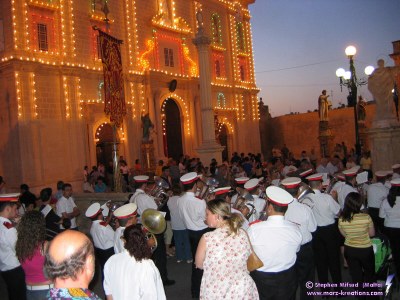
VILLAGE FESTAS IN MALTA
There is something unusually captivating about the typical Maltese village feast or festa. The incessant pealing of the bells during festa week are not just a summons to an ordinary church service, instead they mark the beginning of five consecutive days of spiritual preparation which whole families flock to, in attendance of the solemn thanksgiving on the morning of the patron saint's day (usually a Sunday).
The church is resplendent in its treasures which are specially displayed for the occasion. During this week, to be in the congregation - whatever your creed - is to feel that you belong to a community whose religious enthusiasm cannot fail to touch you deeply. As you elbow your way through the narrow but brightly illuminated and beiagged streets you will certainly be impressed by the sight of so many radiant faces around. The whole atmosphere is pervaded by a 'spirit of spontaneous and carefree rejoicing.
The festivities are organised with meticulous care by the villagers themselves and the pageantry is worthy of an occasion of State. ~The climax is reached during the procession with the life-size statue of the patron saint. Coloured rockets, fireworks, band marches, nougat sellers on make-shift stalls: these are but a few ingredients of the Maltese festa.
On this day a Solemn High Mass is sung in the morning. During this Mass a preacher gives a eulogy on the virtues of the Patron Saint to exhort the faithfully to lead a more exemplary life. This oration is known as the panegyric (in Maltese panigirku).
Solemn Vespers are held again in the evening and the procession follows. This statue is carried shoulder-high to the accompaniment of brass bands. As the procession winds its way very slowly through the streets, the statue is showered with confetti. Coloured rockets are let off well into the night. A special display of these takes place as the procession re-enters the church. This is known as the kaxxa infernali (a corruption of the Italian cassa finale meaning the last box).
The Saint's relic is also carried out in procession by a 'high church dignitary. Those taking part in the procession include various groups of friars, priests wearing richly embroidered church vestments, and the fratelli (literally "brothers"), who are lay members of devotional associations (or confraternities). Each group of fratelli is known as a fratellanza. The members wear colourful robes and they walk behind a huge banner, known as L-Istandard, which is the ensign of their group.
Another characteristic of the procession is the spontaneous show of rejoicing and merry-making in which adults, teenagers and even children take part. It is customary tomarv in several localities for the doors, and windows of private houses to be left open to reveal rooms which almost vie with the dazzling interior of the church itself on festa day, Families also invite their relatives to visit on this day. The festa, after all is not purely a religious event, but also one of the main social events for many Maltese and Gozitans.
|


